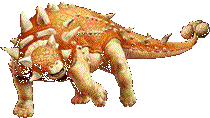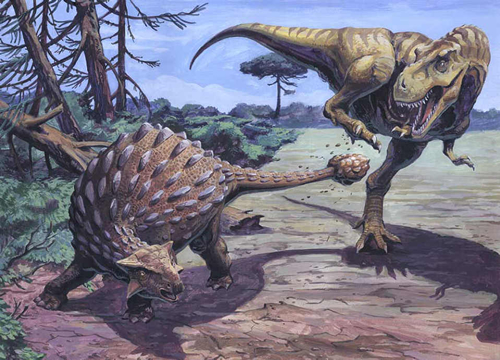Dinosaur Tails
Homepage > Dinosaur Anatomy - Dinosaur
Tails
All dinosaurs evolved with tails. The length and thickness of the tail in relation to the dinosaur's body, its shape, and special features, give us clues to as how the dinosaur used it. The tails of some sauropods were composed of 80 separate tail bones, more than twice the usual number when compared to other dinosaurs.
Dinosaur's tails had many uses. Some sauropods may have used their tails to whip predators, for self-defense. Many large, carnivore dinosaurs which were bipedal, used their thick tails to counter balance the weight of their bodies and heads. Their tails came in handy as well when they needed to make sudden changes in direction while running.
 Other
dinosaurs such as Ankylosaurus had a bony club that was used against their
enemies. These clubs were made of thick, heavy bones, ideal to break bones
or cause internal damage. A blow from this dinosaur could break the ribs
of an attacker or possibly break leg bones.
Other
dinosaurs such as Ankylosaurus had a bony club that was used against their
enemies. These clubs were made of thick, heavy bones, ideal to break bones
or cause internal damage. A blow from this dinosaur could break the ribs
of an attacker or possibly break leg bones.
Duck-billed dinosaurs had flat, long tails, researchers think that they may have used them to swim by swishing them from side to side in the water.
Stegosaurus had a tail with four large spikes. Researchers speculate that Stegosaurus may not have had fine motor control over its tail since they had a small brain, but it would have trashed the tail around to intimidate its enemies. By hitting another dinosaur with its tail, would definitely cause some injuries.

Image courtesy of Eivind Bovor
Interesting Fact [The longest tail belonged to the giant, plant eating, sauropod Diplodocus, it measured 56 feet (17 meters) long.]